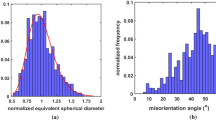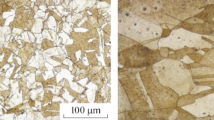Abstract
An investigation on recrystallization textures in high purity face-centered cubic (fcc) aluminum, copper, and nickel indicated that the cube texture is a unique dominant final texture. In a macroview of rolling deformation, a balanced activation of four slip systems can result in certain stability of some substructure with cube orientation in the deformed matrix. In the stable substructure the dislocation density is very low, and the dislocation configuration is rather simple in comparison to other orientations so that the cube substructure can easily be transformed into cube recrystallization nuclei by a recovery process. A high orientation gradient and correspondingly high angle boundaries to the deformed matrix are usually expected around the cube nuclei, which, therefore, grow rapidly. After the primary recrystallization, the size of cube grains is much larger than the grains with other orientations, which will be expensed as the cube grains grow further, so that the cube texture can finally become a dominant texture component.
Similar content being viewed by others
References
W. Köster, Beobachtungen an Kupfer zum Gesetzmäβigen Gefügeaufbau nach der Rekristallisation, Z. Metallkde., Vol 18, 1926, p 112–116 (in German)
G. Ibe, Capacitance and Texture Formation in Aluminum Capacitor Foils, in Directional Properties of Material, H.J. Bunge, Ed., DGM-Informationsgesellschaft, Oberursel, 1988, p 145–156
A. Goyal, D.P. Norton, J.D. Budai, M. Paranthaman, E.D. Specht, D.M. Kroeger, et al., High Critical Current Density Superconducting Tapes by Epitaxial Deposition of YBa2Cu3Ox Thick Films on Biaxially Textured Metals, Appl. Phys. Lett., Vol 69, 1996, p 1795–1797
T. Tomida and T. Tanaka, Development of {100} Texture in Silicon Steel Sheets by Removal of Manganese and Decarburization, ISIJ Int., Vol 35, 1995, p 548–556
H. Hu, Recovery, Recrystallization and Grain Growth, Metallurgical Treatises, J.K. Tien and J.F. Elliott, Ed., Metallurgical Society of AIME, 1981, p 385–407
G. Ibe, W. Dietz, A.C. Fraker, and K. Lücke, Vorzugsorientierungen bei der Rekristallisation Gedehnter Einkristalle aus Reinst-Aluminium, Z. Metallkd., Vol 61, 1970, p 498–507 (in German)
W. Mao, J. Hirsch, and K. Lücke, Influence of the Cube Starting Texture on Rolling and Recrystallization Texture Development, Proceedings of 8th International Conference of Textures of Materials, J.S. Kallend and G. Gottstein, Ed., The Metallurgical Society Inc., Pennsylvania, 1988, p 613–618
W. Mao, Model for Rapidly Moving Boundaries, Science in China, Vol 35, 1992, p 336–343
I.L. Dillamore and H. Katoh, The Mechanisms of Recrystallization in Cubic Metals with Particular Reference to Their Orientation Dependence, Met. Sci., Vol 8, 1974, p 73–83
A.A. Ridha and W.B. Hutchinson, Recrystallization Mechanisms and the Origin of Cube Texture, Acta Metall., Vol 30, 1982, p 1929–1939
W. Mao, Texture in Inhomogeneously Rolled Aluminum Sheet, Trans. Nfsoc., Vol 2, 1992, p 98–103
K. Ito, R. Musick, and K. Lücke, The Influence of Iron Content and Annealing Temperature on the Recrystallization Textures of High-Purity Aluminum-Iron Alloys, Acta Metall., Vol 31, 1983, p 2137–2149
C.B. Thomson and V. Randle, A Study of Twinning in Nickel, Scr. Metall. Mater., Vol 35, 1996, p 385–390
G.D. Köhlhoff, B. Krentscher, and K. Lücke, Texture Development in a Cube Oriented Copper Single Crystal, Proceedings of the 7th International Conference on Textures of Materials, Noordwijkerhoud, 1984, p 95–100
W. Mao, Rolling Texture Development in Aluminum, Chin. J. Met. Sci. Technol. Vol 7, 1991, p 101–112
H.J. Bunge, General Outline and Series Expansion Method, Quantitative Texture Analysis, H.J. Bunge and C. Esling, Ed., DGM-Informationsgesellshaft, Oberursel, 1986, p 1–72
W. Mao, Influence of Widening on the Rolling and Recrystallization Texture in High Purity Al with Initial Cube Texture, Chin. J. Met. Sci. Technol., Vol 6, 1990, p 325–332
W.B. Hutchinson and E. Nes, Evolution of Cube Texture in Copper and Aluminum, Proceedings of the 7th RisØ International Symposium on Metallurgy and Materials Science (Denmark), 1986, p 107–122
C.N. Reid, Deformation Geometry for Materials Scientists, Pergamon Press, 1973, p 145–178
J. Hirsch and K. Lücke, Mechanism of Deformation and Development of Rolling Textures in Polycrystalline fcc Metals—II. Simulation and Interpretation of Experiments on the Basis of Taylor-Type Theories, Acta Metall., Vol 36, 1988, p 2883–2904
Author information
Authors and Affiliations
Rights and permissions
About this article
Cite this article
Mao, W. Formation of recrystallization cube texture in high purity face-centered cubic metal sheets. J. of Materi Eng and Perform 8, 556–560 (1999). https://doi.org/10.1007/s11665-999-0009-3
Received:
Revised:
Issue Date:
DOI: https://doi.org/10.1007/s11665-999-0009-3




